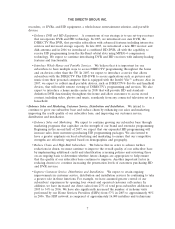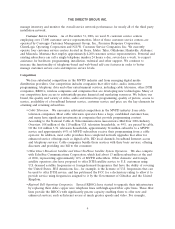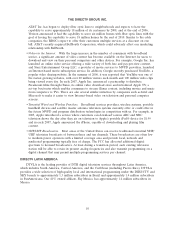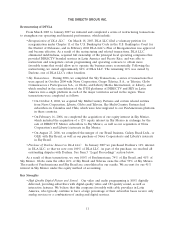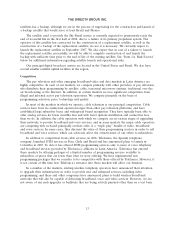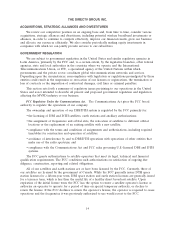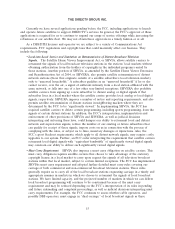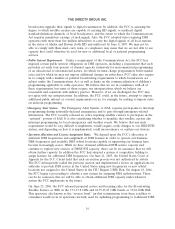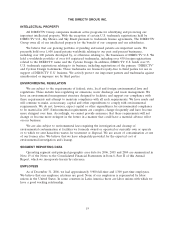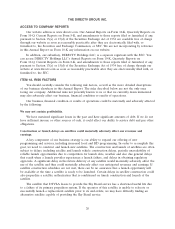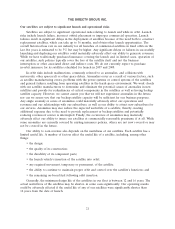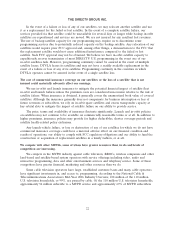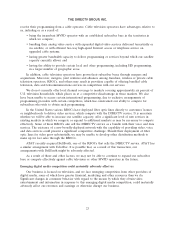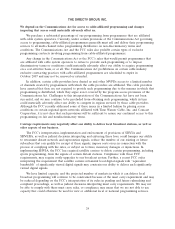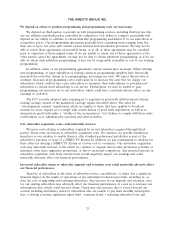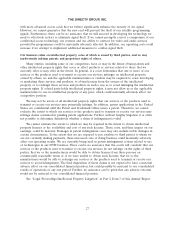DIRECTV 2006 Annual Report Download - page 28
Download and view the complete annual report
Please find page 28 of the 2006 DIRECTV annual report below. You can navigate through the pages in the report by either clicking on the pages listed below, or by using the keyword search tool below to find specific information within the annual report.THE DIRECTV GROUP, INC.
satellites), could provide a new source of additional DTH capacity. FCC decisions on orbital
spacing of reverse band satellites, eligibility to operate such satellites, and other matters may,
however, render this spectrum less useful to us.
•Rules Governing Co-Existence With Other Satellite and Terrestrial Services and Service Providers in
the MVPD Industry. The FCC has adopted rules to allow non-geostationary orbit fixed satellite
services to operate on a co-primary basis in the same frequency band as the one used by direct
broadcast satellite and Ku-Band-based fixed satellite services. In the same proceeding, the FCC
concluded that multi-channel video and data distribution services, or MVDDS, can share
spectrum with DBS operators on a non-interference basis, and adopted rules and a method for
assigning licenses in that service, as well. While the FCC has established service and technical
rules to govern the non-geostationary orbit and MVDDS services to protect DBS operations
from harmful interference, these rules may not be sufficient to prevent such interference, and the
introduction of such services into spectrum used by us for DBS service may have a material
adverse impact on our operations. A number of aspects of these rules remain subject to judicial
review.
On August 18, 2006, the FCC released a notice of proposed rulemaking regarding the possible
operation of ‘‘tweener’’ or ‘‘short spaced’’ satellites—satellites that would operate in the same
DBS uplink and downlink frequency bands as us, from orbital positions located in between those
now assigned to the DBS service. This rulemaking follows applications by SES and Spectrum
Five LLC to operate tweener satellites. Under rules that the FCC is considering, a provider
could, by complying with certain technical restrictions, operate a satellite in between two orbital
locations where we have already positioned our satellites without completing coordination of its
operations with us and without demonstrating that such operations would not ‘‘affect’’ us as that
term is defined by the ITU. We have opposed this proposal, and believe that tweener satellites as
proposed by applicants would cause interference to our current and planned operations and
impose a significant constraint on the further growth of our DIRECTV U.S. DBS service. We
cannot predict what if any action the FCC may take or the effect of such a proceeding on our
business.
On November 29, 2006, despite the pendency of the tweener satellite rulemaking and over
DIRECTV’s opposition, the FCC’s International Bureau granted Spectrum Five’s application to
operate a tweener satellite at the 114.5o WL orbital location, only 4.5o away from DIRECTV’s
DBS satellites operating at the 110o WL and 119o WL orbital locations. While the Bureau limited
Spectrum Five’s operations to levels below those at which the ITU deems one DBS system to
‘‘affect’’ another in the absence of agreement from all affected DBS operators (including us), the
Bureau’s grant of Spectrum Five’s application prior to coordination could ultimately permit
Spectrum Five to operate at levels that would cause interference to our operations. We have
sought review of the Bureau’s order by the full FCC.
The FCC also recently adopted rules that require satellite operators to take certain measures to
mitigate the dangers of orbital debris. Among other things, these rules impose certain
requirements for satellite design and end-of-life disposal maneuvers for all satellites launched
after March 18, 2002, which include DIRECTV 5, DIRECTV 8, DIRECTV 7S, DIRECTV 9S,
SPACEWAY 1, and SPACEWAY 2. We believe that we are in compliance with all of these
requirements and expect that we will continue to be able to comply with them going forward, but
the requirements for end-of-life disposal could result in a slight reduction in the operational life
of each new satellite.
17


